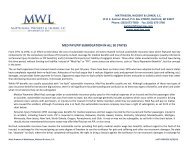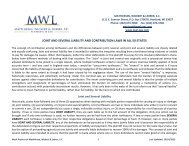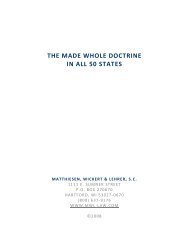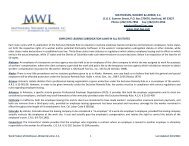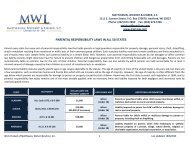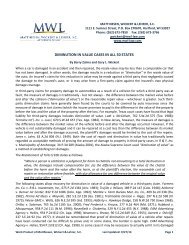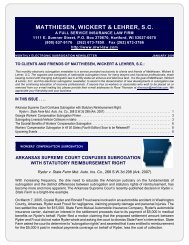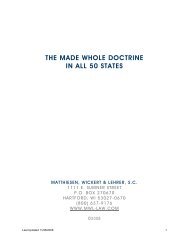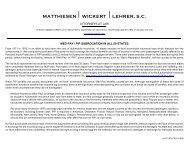SANCTIONS: Spoliation sanctions are typic<strong>all</strong>y imposed where one party ga<strong>in</strong>s an evidentiary advantage over theoppos<strong>in</strong>g party by fail<strong>in</strong>g to preserve <strong>evidence</strong>. Himes v. Wood<strong>in</strong>gs-Verona Tool Works, Inc., 565 N.W.2d 469,471 (M<strong>in</strong>n. App. 1997), review denied (M<strong>in</strong>n. 1997). This is true where the spoliator knew or should have knownthat the <strong>evidence</strong> should be preserved for pend<strong>in</strong>g or future litigation; the <strong>in</strong>tent <strong>of</strong> the spoliator is irrelevant.Patton v. Newmar Corp., 538 N.W.2d 116, 119 (M<strong>in</strong>n. 1995). When the <strong>evidence</strong> is under the exclusive control <strong>of</strong>the party who fails to produce it, M<strong>in</strong>nesota permits the jury to <strong>in</strong>fer that “the <strong>evidence</strong>, if produced, would havebeen unfavorable to that party.” Litchfield Precision Components, Inc., 456 N.W.2d at 437. Furthermore, thepropriety <strong>of</strong> a sanction for the <strong>spoliation</strong> <strong>of</strong> <strong>evidence</strong> is determ<strong>in</strong>ed by the prejudice result<strong>in</strong>g to the oppos<strong>in</strong>gparty. Prejudice is determ<strong>in</strong>ed by consider<strong>in</strong>g the nature <strong>of</strong> the item lost <strong>in</strong> the context <strong>of</strong> the claims assertedand the potential for correct<strong>in</strong>g the prejudice. Patton, 538 N.W.2d at 119. Adverse Inference InstructionMichigan, Civ. J.I.G. § 12.35, reads that, “If either party does not produce <strong>evidence</strong> that the party couldreasonably be expected to produce and <strong>in</strong>tention<strong>all</strong>y destroys <strong>evidence</strong> which that party has been ordered toproduce and fails to give a reasonable explanation, you may decide that the…<strong>evidence</strong> would have beenunfavorable to that party.”MISSISSIPPITORT OF SPOLIATION: In Dowdle, the Mississippi Supreme Court refused to “recognize a separate tort for<strong>in</strong>tentional <strong>spoliation</strong> <strong>of</strong> <strong>evidence</strong> aga<strong>in</strong>st both first and third-party spoliators.” Dowdle Butane Gas Co. v. Moore,831 So.2d 1124, 1135 (Miss. 2002). In Richardson the Court likewise refused to recognize a separate tort fornegligent <strong>spoliation</strong> <strong>of</strong> <strong>evidence</strong>. Richardson v. Sara Lee Corp., 847 So.2d 821, 824 (Miss. 2003).ADVERSE INFERENCE/PRESUMPTION: In Stahl v. Wal-Mart Stores, Inc., 47 F.Supp.2d 783, 787 n. 3 (S.D. Miss.1998), the Court held that “<strong>in</strong> the absence <strong>of</strong> bad faith – i.e., <strong>evidence</strong> <strong>of</strong> culpability on the part <strong>of</strong> the spoliator –then there can be no adverse <strong>in</strong>fluence or presumption…even when there is prejudice to the <strong>in</strong>nocent party.” TheCourt further held “it is a general rule that the <strong>in</strong>tentional <strong>spoliation</strong> or destruction <strong>of</strong> <strong>evidence</strong> relevant to a caseraises a presumption, or, more properly, an <strong>in</strong>ference, that this <strong>evidence</strong> would have been unfavorable to thecase <strong>of</strong> the spoliator.” Tolbert v. State, 511 So.2d 1368, 1372-73 (Miss. 1987), quot<strong>in</strong>g Wash<strong>in</strong>gton v. State, 478So.2d 1028, 1032-33 (Miss. 1985). “Such a presumption or <strong>in</strong>ference arises, however, only when the <strong>spoliation</strong> ordestruction was <strong>in</strong>tentional and <strong>in</strong>dicates fraud and a desire to suppress the truth and it does not rise where thedestruction was a matter <strong>of</strong> rout<strong>in</strong>e with no fraudulent <strong>in</strong>tent.” Id.SANCTIONS: Spoliation remedies <strong>in</strong>clude discovery sanctions, crim<strong>in</strong>al penalties or discipl<strong>in</strong>ary actions aga<strong>in</strong>stattorneys who participate <strong>in</strong> <strong>spoliation</strong>. Dowdle, supra. Mississippi recognizes a refutable “negative” or adverse<strong>in</strong>ference aga<strong>in</strong>st a spoliator. Thomas v. Isle <strong>of</strong> Capri Cas<strong>in</strong>o, 781 So.2d 125 (Miss. 2001).MISSOURIADVERSE INFERENCE: A party who <strong>in</strong>tention<strong>all</strong>y destroys or significantly alters <strong>evidence</strong> is subject to an adverseevidentiary <strong>in</strong>ference under the Spoliation <strong>of</strong> Evidence Doctr<strong>in</strong>e. Baldridge v. Director <strong>of</strong> Revenue, 82 S.W.3d212, 222 (Mo. App. 2002). ”[T]he destruction <strong>of</strong> written <strong>evidence</strong> without satisfactory explanation gives rise to an<strong>in</strong>ference unfavorable to the spoliator.” Garrett v. Term<strong>in</strong>al R. Ass’n <strong>of</strong> St. Louis, 259 S.W.2d 807, 812 (Mo. 1953).“Similarly, where one party has obta<strong>in</strong>ed possession <strong>of</strong> physical <strong>evidence</strong> which [the party] fails to produce oraccount for at the trial, an <strong>in</strong>ference is warranted aga<strong>in</strong>st that party.” State ex rel. St. Louis County Transit Co. v.Walsh, 327 S.W.2d 713, 717 (Mo. App. 1959). “[W]here one conceals or suppresses <strong>evidence</strong> such actionwarrants an unfavorable <strong>in</strong>ference.” Id. at 717-18.When an adverse <strong>in</strong>ference is urged, it is necessary that there be <strong>evidence</strong> show<strong>in</strong>g <strong>in</strong>tentional destruction <strong>of</strong>the item, and also such destruction must occur under circumstances which give rise to an <strong>in</strong>ference <strong>of</strong> fraud anda desire to suppress the truth. In such cases, it may be shown by the proponent that the <strong>all</strong>eged spoliator had aduty, or should have recognized a duty, to preserve the <strong>evidence</strong>. Morris v. J.C. Penney Life Ins. Co., 895 S.W.2d73, 77-78 (Mo. App. 1995). “S<strong>in</strong>ce the doctr<strong>in</strong>e <strong>of</strong> <strong>spoliation</strong> is a harsh rule <strong>of</strong> <strong>evidence</strong>, prior to apply<strong>in</strong>g it <strong>in</strong> any10Work Product <strong>of</strong> <strong>Matthiesen</strong>, <strong>Wickert</strong> & <strong>Lehrer</strong>, S.C. LAST UPDATED 4/22/2013
given case, it should be the burden <strong>of</strong> the party seek<strong>in</strong>g its benefit to make a prima facie show<strong>in</strong>g the opponentdestroyed the miss<strong>in</strong>g [<strong>evidence</strong>] under circumstances manifest<strong>in</strong>g fraud, deceit or bad faith.” Baldridge, supra.Simple negligence is not sufficient to apply the Adverse Inference Rule. Brissette v. Milner Chevrolet Co., 479S.W.2d 176, 182 (Mo. App. 1972).MONTANATORT OF SPOLIATION: Montana courts have adopted the torts <strong>of</strong> both <strong>in</strong>tentional and negligent <strong>spoliation</strong>aga<strong>in</strong>st third parties. Negligent <strong>spoliation</strong> <strong>of</strong> <strong>evidence</strong> consists <strong>of</strong> the follow<strong>in</strong>g elements: (1) existence <strong>of</strong> apotential civil action; (2) legal or contractual duty to preserve <strong>evidence</strong> relevant to that action; (3) destruction <strong>of</strong>that <strong>evidence</strong>; (4) significant impairment <strong>of</strong> the ability to prove the potential civil action; (5) causal connectionbetween the destruction <strong>of</strong> the <strong>evidence</strong> and the <strong>in</strong>ability to prove the lawsuit; (6) significant possibility <strong>of</strong>success <strong>of</strong> the potential civil action if the <strong>evidence</strong> were available; and (7) damages. Gentry v. Douglas HerefordRanch, Inc., 1998 Mont. 182, 290 Mont. 126, 962 P.2d 1205 (Mont. 1998); Oliver v. Stimson Lumber Co., 297Mont. 336, 345-354, 993 P.2d 11, 18-23 (Mont. 1999). Intentional <strong>spoliation</strong> consists <strong>of</strong> the follow<strong>in</strong>g elements:(1) the existence <strong>of</strong> a potential lawsuit; (2) the defendant’s knowledge <strong>of</strong> the potential lawsuit; (3) the<strong>in</strong>tentional destruction <strong>of</strong> <strong>evidence</strong> designed to disrupt or defeat the potential lawsuit; (4) disruption <strong>of</strong> thepotential lawsuit; (5) a causal relationship between the act <strong>of</strong> <strong>spoliation</strong> and the <strong>in</strong>ability to prove the lawsuit;and (6) damages. Id.Under Montana law, the tort <strong>of</strong> <strong>spoliation</strong> <strong>of</strong> <strong>evidence</strong> (whether <strong>in</strong>tentional or negligent) requires “the existence<strong>of</strong> a potential lawsuit.” Oliver v. Stimson Lumber Co., 297 Mont. 336, 993 P.2d 11, 21 (Mont. 1999). Spoliation <strong>of</strong><strong>evidence</strong> can only occur <strong>in</strong> connection with some other lawsuit; it is <strong>in</strong>tr<strong>in</strong>sic<strong>all</strong>y bound up <strong>in</strong> the sametransaction as the underly<strong>in</strong>g lawsuit. Smith v. Salish Kootenai College, 378 F.3d 1048, 1058 (9 th Cir. Mont. 2004).NEBRASKAADVERSE INFERENCE: When <strong>in</strong>tentional destruction <strong>of</strong> <strong>evidence</strong> is established, the fact f<strong>in</strong>der may draw the<strong>in</strong>ference that the <strong>evidence</strong> destroyed was unfavorable to the party responsible for its destruction. State v.Davl<strong>in</strong>, 263 Neb. 283, 639 N.W.2d 631 (Neb. 2002); Trieweiler v. Sears, 268 Neb. 952, 992, 689 N.W.2d 807, 843(Neb. 2004).NEVADATORT OF SPOLIATION: Nevada does not recognize a separate tort for first-party or third-party <strong>spoliation</strong> <strong>of</strong><strong>evidence</strong>. Timber Tech Eng<strong>in</strong>eered Bldg. Products v. The Home Ins. Co., 55 P.3d 952, 953-54 (Nev. 2002).ADVERSE INFERENCE: “It is well-established that a party is entitled to jury <strong>in</strong>structions on every theory <strong>of</strong> hercase that is supported by the <strong>evidence</strong>.” Bass-Davis v. Davis, 117 P.3d 207, 209 (Nev. 2005). In Re<strong>in</strong>gold v. Wet ‘NWild Nevada, Inc., 113 Nev. 967, 970, 944 P.2d 800, 802 (Nev. 1997), the Nevada Supreme Court recognized thatunder N.R.S. § 47.2<strong>50</strong>(3), when <strong>evidence</strong> is willfully destroyed, the trier <strong>of</strong> fact is entitled to presume that the<strong>evidence</strong> was adverse to the destroy<strong>in</strong>g party. It further held that <strong>evidence</strong> is “willfully” destroyed even if the<strong>evidence</strong> is destroyed pursuant to an established company policy. Bass-Davis v. Davis, 117 P.3d at 210.NEW HAMPSHIREADVERSE INFERENCE: An adverse <strong>in</strong>ference – that the miss<strong>in</strong>g <strong>evidence</strong> would have been unfavorable – can bedrawn only when the <strong>evidence</strong> was destroyed deliberately with a fraudulent <strong>in</strong>tent. Rodriguez v. Webb, 141 N.H.177, 180, 680 A.2d 604 (N.H. 1996). The tim<strong>in</strong>g <strong>of</strong> the document destruction is not dispositive on the issue <strong>of</strong><strong>in</strong>tent, however, and an adverse <strong>in</strong>ference can be drawn even when the <strong>evidence</strong> is destroyed prior to a claimbe<strong>in</strong>g made. Id. at 178, 180, 680 A.2d 604; Murray v. Developmental Services <strong>of</strong> Sullivan County, Inc., 149 N.H.11Work Product <strong>of</strong> <strong>Matthiesen</strong>, <strong>Wickert</strong> & <strong>Lehrer</strong>, S.C. LAST UPDATED 4/22/2013



